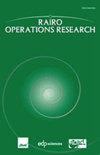关于分裂图的两个变体:2-单极图和k-探针分裂图
IF 1.8
4区 管理学
Q3 OPERATIONS RESEARCH & MANAGEMENT SCIENCE
引用次数: 0
摘要
如果图的顶点集可以划分为稳定集和团,则称之为分裂图。在本文中,我们研究了分裂图的两个变体。如果图G的顶点集可以划分为两个集合A和B,使得G[A]是完全多部图,G[B]是完全图的不相交并,则图G是极的。一个2-单极图是一个极坐标图G,使得G[A]是一个团,G[B]是最多有两个顶点的完全图的不相交并。提出了2-单极图的最小禁止诱导子图刻划。此外,我们证明它们可以表示为特殊仙人掌的子星的交集。设G是一个图类,图G的G宽度是最小正整数k,使得存在k个独立集N1,…,Nk使得G的非边集合F,其端点属于某个Ni,且i = 1,…当图G的宽度不超过k时,我们称图G为k-probe-G,当G是分割图的一类时,我们称图G为k-probe-split。我们证明了给定一个图G和一个正整数k,判定G是否是一个h≤k的h探针分割图是np完全的。此外,给出了用最小禁止诱导子图刻画2-问题分割图的方法。本文章由计算机程序翻译,如有差异,请以英文原文为准。
On two variants of split graphs: 2-unipolar graph and k-probe-split graph
A graph is called split if its vertex set can be partitioned into a stable set and a clique. In this article, we studied two variants of split graphs. A graph G is polar if its vertex set can be partitioned into two sets A and B such that G[A] is a complete multipartite graph and G[B] is a disjoint union of complete graphs. A 2-unipolar graph is a polar graph G such that G[A] is a clique and G[B] is the disjoint union of complete graphs with at most two vertices. We present a minimal forbidden induced subgraph characterization for 2-unipolar graphs. In addition, we show that they can be represented as an intersection of substars of special cacti. Let G be a graph class, the G-width of a graph G is the minimum positive integer k such that there exist k independent sets N1,...,Nk such that a set F of nonedges of G, whose endpoints belong to some Ni with i = 1,...,k, can be added so that the resulting graph G0 belongs to G. We say that a graph G is k-probe-G if it has G-width at most k and when G is the class of split graphs it is denominated k-probe-split. We prove that deciding, given a graph G and a positive integer k, whether G is a h-probe-split graph for some h ≤ k is NP-complete. Besides, a characterization by minimal forbidden induced subgraphs for 2-probesplit cographs is presented.
求助全文
通过发布文献求助,成功后即可免费获取论文全文。
去求助
来源期刊

Rairo-Operations Research
管理科学-运筹学与管理科学
CiteScore
3.60
自引率
22.20%
发文量
206
审稿时长
>12 weeks
期刊介绍:
RAIRO-Operations Research is an international journal devoted to high-level pure and applied research on all aspects of operations research. All papers published in RAIRO-Operations Research are critically refereed according to international standards. Any paper will either be accepted (possibly with minor revisions) either submitted to another evaluation (after a major revision) or rejected. Every effort will be made by the Editorial Board to ensure a first answer concerning a submitted paper within three months, and a final decision in a period of time not exceeding six months.
 求助内容:
求助内容: 应助结果提醒方式:
应助结果提醒方式:


